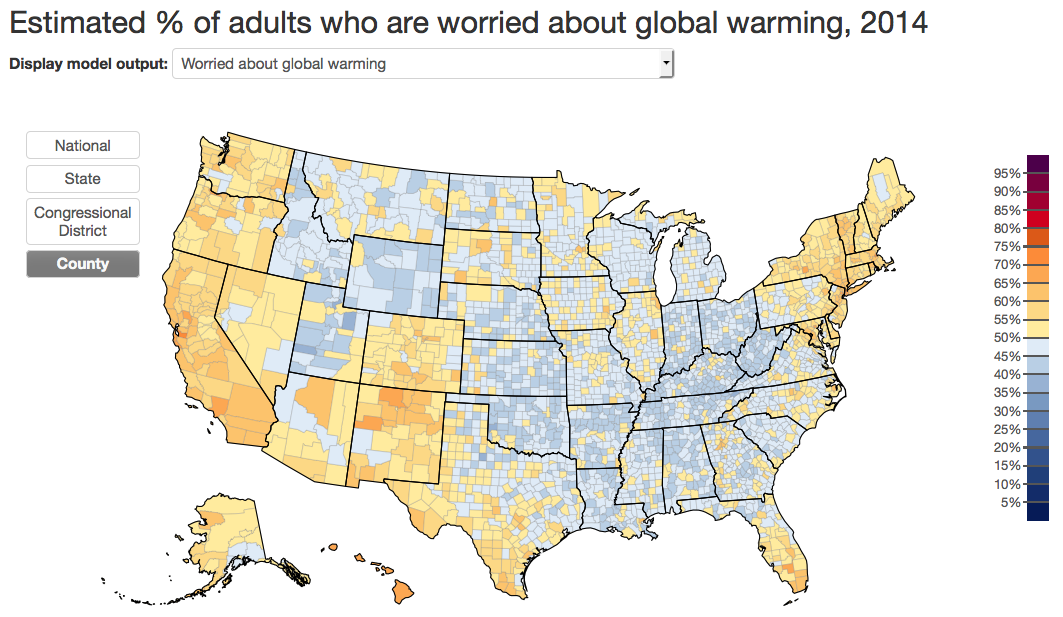Where in the US Are People Most Worried About Climate Change?

Residents in California are much more worried about the warming planet than those in parts of the central United States, according to a new set of interactive maps showing public opinion on climate change.
As a nation, 63 percent of Americans think the planet is warming and 48 percent of Americans think these changes are caused by humans. But "Americans don't speak with a single voice on the issue," said Anthony Leiserowitz, director of the Yale Project on Climate Change Communication and co-author of the new paper published online April 6 in the journal Nature Climate Change. "In fact, there's a tremendous diversity across the country about it."
Leiserowitz and his colleagues from Yale and Utah State University estimated what people in different states, local communities and congressional districts think, in order to tease out smaller trends. The researchers also created the interactive map based on their new data. "I use this analogy loosely, but it's like getting a microscope for the first time," Leiserowitz told Live Science. "Suddenly, you can see this whole world below the surface that you just couldn't see before." [6 Unexpected Effects of Climate Change]
A few trends can be pulled from the data, the researchers said. The first is that diversity is present on the state, district and county levels. Very few states contain congressional districts and counties that mostly agree with one another. For example, it's not uncommon to see neighboring counties disagree with one another by 10 to 20 percent.
When it comes to who is worried about climate change, four states stand out: Hawaii, California, Vermont and Massachusetts. All three are blanketed in orange, meaning that at least 50 percent of the people in every county are concerned about climate change. This may be expected given California's current drought and Massachusetts' recent record-breaking winter.
The research is based on data from 12 surveys conducted between 2008 and 2013. Broadly, the surveys addressed three topics: beliefs, risk perceptions and policy support. So a person would be asked if he or she believed global warming is happening, if he or she is worried about global warming, and if he or she supports research into renewable energies, among other questions. Each question was phrased exactly the same way for each person.
With 13,000 people surveyed, the researchers could make claims about the national scale, but nothing below that. So, Leiserowitz and his colleagues looked for patterns in the way people responded on each of the surveys, and then developed predictions. The idea was to project public opinion on climate change based on demographic and geographic data.
Sign up for the Live Science daily newsletter now
Get the world’s most fascinating discoveries delivered straight to your inbox.
In order to verify those estimates, the team then conducted multiple state and city surveys. In the end, the surveys matched the researchers' models surprisingly well. "To be honest, we don't know which is more accurate," Leiserowitz said. Just as the models will have an inherent error, so too do the surveys.
The research team developed the map for two reasons. The first was scientifically motivated. The researchers wanted to see the diversity hidden beneath a single national average. The second reason was practically motivated. Most of the decision-making about climate change will happen at the local and state levels, Leiserowitz said. Vulnerability to certain extreme events, for example, can already be seen at that localized level.
One surprising result is the diversity of colors in southwest Texas. "We often think of Texas as a deep-red, conservative state," Leiserowitz said. "But when you look inside the state, you actually see there's tremendous diversity in belief about climate change, worry about climate change, support for climate policies and so on."
Leiserowitz said he thinks that a higher Latino population in southwest Texas is affecting the regional data. Previous research shows that Latinos care more about climate change than any other regional ethnic group in the United States. And, in fact, worldwide surveys reveal that people in Central and South American countries are far more concerned about climate change than people in any other countries. Leiserowitz said he suspects that the worry is culturally driven, but he has yet to test this hypothesis.
The interactive map is "just opening up literally hundreds of new research questions that we haven't even gotten to yet because we're just starting to delve into it," Leiserowitz said.
The researchers have many plans for how to use the maps. They'll partly extend the project to include data from other survey questions, and they'll push the model further, into smaller geographies, Leiserowitz said. The team will also look at these same trends over time. This will help the public see whether or not certain geographic events actually caused changes in climate change perception.
Follow Shannon Hall on Twitter @ShannonWHall. Follow Live Science @livescience, Facebook & Google+. Original article on Live Science.









